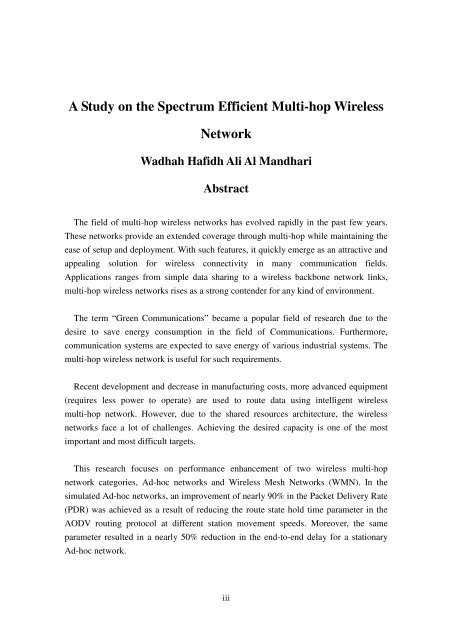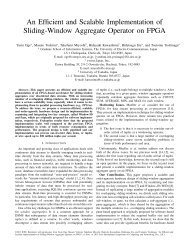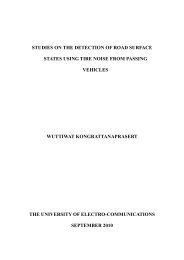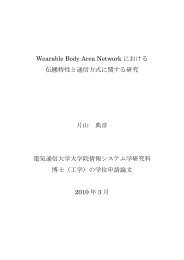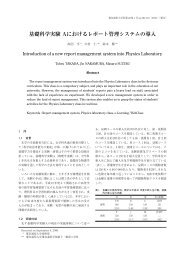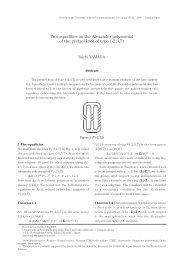a study on the spectrum efficient multi-hop wireless network
a study on the spectrum efficient multi-hop wireless network
a study on the spectrum efficient multi-hop wireless network
Create successful ePaper yourself
Turn your PDF publications into a flip-book with our unique Google optimized e-Paper software.
A Study <strong>on</strong> <strong>the</strong> Spectrum Efficient Multi-<strong>hop</strong> Wireless<br />
Network<br />
Wadhah Hafidh Ali Al Mandhari<br />
Abstract<br />
The field of <strong>multi</strong>-<strong>hop</strong> <strong>wireless</strong> <strong>network</strong>s has evolved rapidly in <strong>the</strong> past few years.<br />
These <strong>network</strong>s provide an extended coverage through <strong>multi</strong>-<strong>hop</strong> while maintaining <strong>the</strong><br />
ease of setup and deployment. With such features, it quickly emerge as an attractive and<br />
appealing soluti<strong>on</strong> for <strong>wireless</strong> c<strong>on</strong>nectivity in many communicati<strong>on</strong> fields.<br />
Applicati<strong>on</strong>s ranges from simple data sharing to a <strong>wireless</strong> backb<strong>on</strong>e <strong>network</strong> links,<br />
<strong>multi</strong>-<strong>hop</strong> <strong>wireless</strong> <strong>network</strong>s rises as a str<strong>on</strong>g c<strong>on</strong>tender for any kind of envir<strong>on</strong>ment.<br />
The term “Green Communicati<strong>on</strong>s” became a popular field of research due to <strong>the</strong><br />
desire to save energy c<strong>on</strong>sumpti<strong>on</strong> in <strong>the</strong> field of Communicati<strong>on</strong>s. Fur<strong>the</strong>rmore,<br />
communicati<strong>on</strong> systems are expected to save energy of various industrial systems. The<br />
<strong>multi</strong>-<strong>hop</strong> <strong>wireless</strong> <strong>network</strong> is useful for such requirements.<br />
Recent development and decrease in manufacturing costs, more advanced equipment<br />
(requires less power to operate) are used to route data using intelligent <strong>wireless</strong><br />
<strong>multi</strong>-<strong>hop</strong> <strong>network</strong>. However, due to <strong>the</strong> shared resources architecture, <strong>the</strong> <strong>wireless</strong><br />
<strong>network</strong>s face a lot of challenges. Achieving <strong>the</strong> desired capacity is <strong>on</strong>e of <strong>the</strong> most<br />
important and most difficult targets.<br />
This research focuses <strong>on</strong> performance enhancement of two <strong>wireless</strong> <strong>multi</strong>-<strong>hop</strong><br />
<strong>network</strong> categories, Ad-hoc <strong>network</strong>s and Wireless Mesh Networks (WMN). In <strong>the</strong><br />
simulated Ad-hoc <strong>network</strong>s, an improvement of nearly 90% in <strong>the</strong> Packet Delivery Rate<br />
(PDR) was achieved as a result of reducing <strong>the</strong> route state hold time parameter in <strong>the</strong><br />
AODV routing protocol at different stati<strong>on</strong> movement speeds. Moreover, <strong>the</strong> same<br />
parameter resulted in a nearly 50% reducti<strong>on</strong> in <strong>the</strong> end-to-end delay for a stati<strong>on</strong>ary<br />
Ad-hoc <strong>network</strong>.<br />
iii


